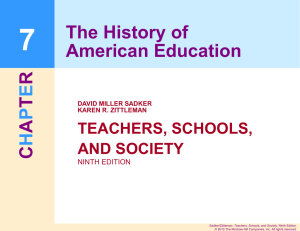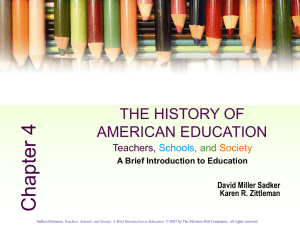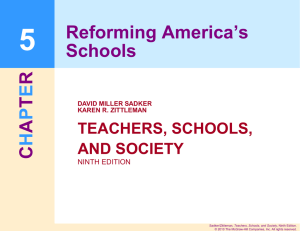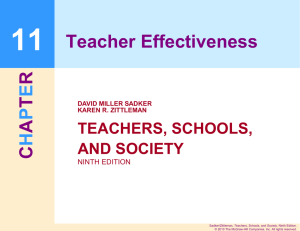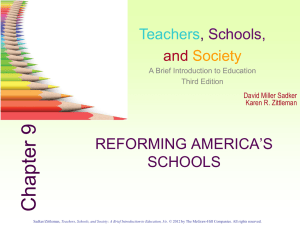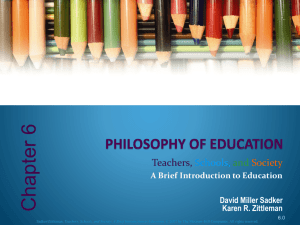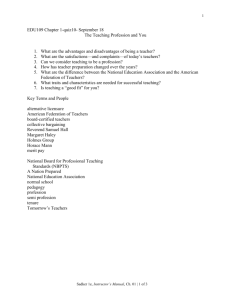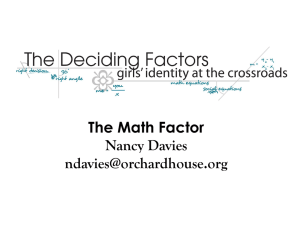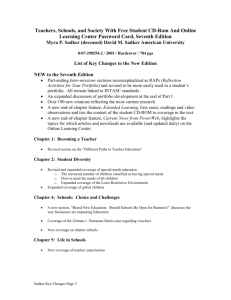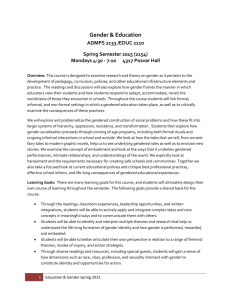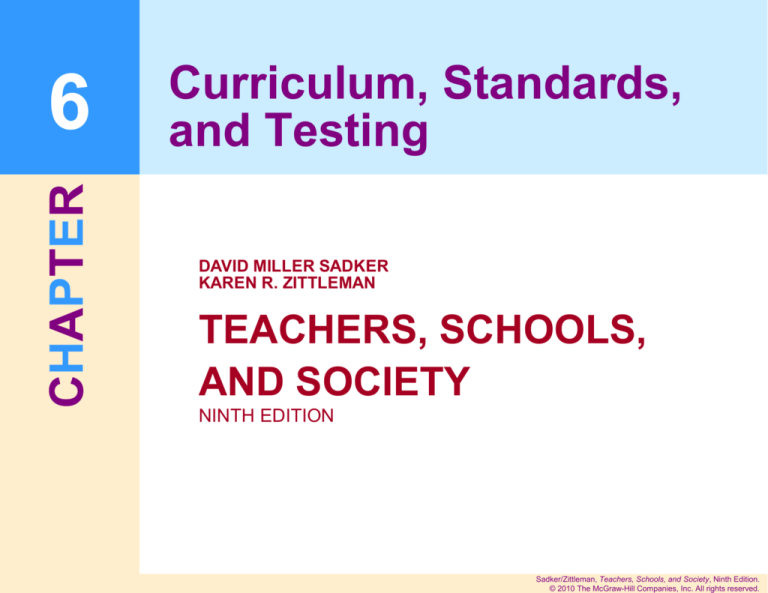
CHAPTER
6
Curriculum, Standards,
and Testing
DAVID MILLER SADKER
KAREN R. ZITTLEMAN
TEACHERS, SCHOOLS,
AND SOCIETY
NINTH EDITION
Sadker/Zittleman, Teachers, Schools, and Society, Ninth Edition.
© 2010 The McGraw-Hill Companies, Inc. All rights reserved.
6.1
EDUCATIONAL TIME LINE
TIME
EDUCATIONAL
PHILOSOPHY
FOCUS OF CURRICULUM
Seventeenth
Century
“Two Rs”
Secondary education for males
only; reading and religion
Eighteenth
Century
Life in the present
Reading, religion, morality,
writing, and arithmetic; vocational
skills; academy open to females
Nineteenth
Century
Secular education
Secondary education in Latin or
English curriculum
Early Twentieth
Century
Progressive education
Creative expression; junior high
school developed; secondary
education for all students
Sadker/Zittleman, Teachers, Schools, and Society, Ninth Edition.
© 2010 The McGraw-Hill Companies, Inc. All rights reserved.
6.2
EDUCATIONAL TIME LINE (continued)
TIME
EDUCATIONAL
PHILOSOPHY
1940s-1960s
Discipline-oriented
Congress funded programs in
science, math, languages, and
guidance
1960s-1970s
Social concern and
humanistic education
Gender-based courses;
multiethnic curricula
1980s
Back to basics
Academic subjects emphasized;
increased discipline; elimination
of electives; competency exams
1990s
Widening of the core
curriculum
Expansion of the core curriculum
to include more people of color
and women
Current
_____________
________________
FOCUS OF CURRICULUM
Sadker/Zittleman, Teachers, Schools, and Society, Ninth Edition.
© 2010 The McGraw-Hill Companies, Inc. All rights reserved.
6.3
HIDDEN CURRICULUM?
Student Generated Responses: What else did you learn in school?
GRADE LEVEL
“HIDDEN” LESSONS
Elementary
Middle
High School
Sadker/Zittleman, Teachers, Schools, and Society, Ninth Edition.
© 2010 The McGraw-Hill Companies, Inc. All rights reserved.
6.4
THE IMPORTANCE OF EXTRACURRICULAR ACTIVITIES
AND ACADEMIC SUBJECTS
Do you consider extracurricular activities as important as the academic
subjects, or do you consider them as only a supplement to the academic
subjects?
National Totals
%
No Children in
School
%
Public School
Parents
%
As important as
academic subjects
42
40
46
A supplement to
academic subjects
56
58
52
Don’t know
2
2
2
Source: Lowell C. Rose and Alec M. Gallup (2000), The 32nd Annual Phi Delta Kappa/Gallup Poll of the Public’s Attitudes Toward the Public Schools, http://www.pdkintl.org/kappan/kpol0009.htm#1a
Sadker/Zittleman, Teachers, Schools, and Society, Ninth Edition.
© 2010 The McGraw-Hill Companies, Inc. All rights reserved.
6.5
Figure 6.1
SHAPING THE CURRICULUM
Sadker/Zittleman, Teachers, Schools, and Society, Ninth Edition.
© 2010 The McGraw-Hill Companies, Inc. All rights reserved.
6.6
WHO AND WHAT SHAPE THE CURRICULUM?
Student Generated Responses
WHO & WHAT
1.
Students
2.
Parental and community groups
3.
Teachers
4.
Administrators
5.
Federal government
6.
State government
7.
Local government
8.
Colleges and universities
9.
Standardized tests
EXAMPLES OF HOW
10. Education commissions and
committees
11. Professional organizations
12. Special interest groups
Sadker/Zittleman, Teachers, Schools, and Society, Ninth Edition.
© 2010 The McGraw-Hill Companies, Inc. All rights reserved.
6.7
THE DIGITAL DIVIDE ON COMPUTER USE
Source: National Center for Education Statistics, Digest of Education Statistics, 2008 (Issued March 2009).
Figure 6.2
Sadker/Zittleman, Teachers, Schools, and Society, Ninth Edition.
© 2010 The McGraw-Hill Companies, Inc. All rights reserved.
6.8
TEXTBOOK ADOPTION STATES
Source: American Association of Publishers, Washington, DC, 2009.
Figure 6.3
Sadker/Zittleman, Teachers, Schools, and Society, Ninth Edition.
© 2010 The McGraw-Hill Companies, Inc. All rights reserved.
6.9
FORMS OF BIAS
Student Generated Responses
BIAS
EXAMPLES
Invisibility
Stereotyping
Imbalance/selectivity
Unreality
Fragmentation/isolation
Linguistic bias
Cosmetic bias
Sadker/Zittleman, Teachers, Schools, and Society, Ninth Edition.
© 2010 The McGraw-Hill Companies, Inc. All rights reserved.
6.10 THREE TYPES OF STANDARDS
Student Generated Responses
1. Content standards
2. Performance standards
3. Opportunity-to-learn standards
Sadker/Zittleman, Teachers, Schools, and Society, Ninth Edition.
© 2010 The McGraw-Hill Companies, Inc. All rights reserved.
6.11 WHEN STUDENTS DO POORLY
If students in your district did poorly on a standardized test, which
might be your reaction?
•
The schools failed to prepare students.
•
•
Something was wrong with the test design.
The students lack ability.
•
Don’t know.
How do we vote?
Sadker/Zittleman, Teachers, Schools, and Society, Ninth Edition.
© 2010 The McGraw-Hill Companies, Inc. All rights reserved.
6.12 NO CHILD LEFT BEHIND (2001)
• Annual testing
• Adequate yearly progress (AYP)
• Report cards
• Highly qualified faculty
• What other areas of the law are
less well known?
Sadker/Zittleman, Teachers, Schools, and Society, Ninth Edition.
© 2010 The McGraw-Hill Companies, Inc. All rights reserved.
SEVEN REASONS WHY STANDARDIZED TESTS
6.13
ARE NOT WORKING
1. At-risk students placed at greater risk
2. Lower graduation rates
3. Higher test scores do not mean more learning
4. Standardized testing shrinks the curriculum
5. Test errors
6. Teacher stress
7. What’s worth knowing?
Sadker/Zittleman, Teachers, Schools, and Society, Ninth Edition.
© 2010 The McGraw-Hill Companies, Inc. All rights reserved.
6.14 TEACHING TO THE TEST
Source: Education Week, Quality Counts, 2001.
Sadker/Zittleman, Teachers, Schools, and Society, Ninth Edition.
© 2010 The McGraw-Hill Companies, Inc. All rights reserved.
6.15 TEACHER STRESS
Source: A female teacher with a literature specialty teaching in a suburban elementary school.
http://ganesh.ed.asu.edu/aims/view_image.php?image_id=72&grade_range_id=3
Figure 6.4
Sadker/Zittleman, Teachers, Schools, and Society, Ninth Edition.
© 2010 The McGraw-Hill Companies, Inc. All rights reserved.
6.16 DO YOU BELIEVE IN EVOLUTION?
Source: “Trend Lines: Acceptance of Evolution,” The Washington Post, January 16, 2007.
Figure 6.5
Sadker/Zittleman, Teachers, Schools, and Society, Ninth Edition.
© 2010 The McGraw-Hill Companies, Inc. All rights reserved.
6.17 EXAMPLES OF CENSORSHIP
Mary Rodgers’ Freaky Friday: “Makes fun of parents and parental responsibility.”
Plato’s Republic: “This book is un-Christian.”
Jules Verne’s Around the World in Eighty Days: “Very unfavorable to Mormons.”
William Shakespeare’s Macbeth: “Too violent for children.”
Fyodor Dostoyevsky’s Crime and Punishment: “Serves as a poor model for young people.”
Herman Melville’s Moby Dick: “Contains homosexuality.”
Anne Frank’s Diary of a Young Girl: “Obscene and blasphemous.”
E. B. White’s Charlotte’s Web: “Morbid picture of death.”
J. R. R. Tolkien’s The Hobbit: “Subversive elements.”
Roald Dahl’s Charlie and the Chocolate Factory: “Racist.”
Mark Twain’s The Adventures of Huckleberry Finn: “Racism, insensitivity, and offensive
language.”
Webster’s Dictionary: “Contains sexually explicit definitions.”
Justin Richardson and Peter Parnell’s And Tango Makes Three, for being anti-ethnic and
anti-family, homosexuality, religious viewpoint, unsuited to the age group.
Philip Pullman’s His Dark Materials trilogy for the political viewpoint, religious viewpoint,
and violence.
Alvin Schwartz’s Scary Stories for occult/satanism, religious viewpoint, and violence.
Sadker/Zittleman, Teachers, Schools, and Society, Ninth Edition.
© 2010 The McGraw-Hill Companies, Inc. All rights reserved.

